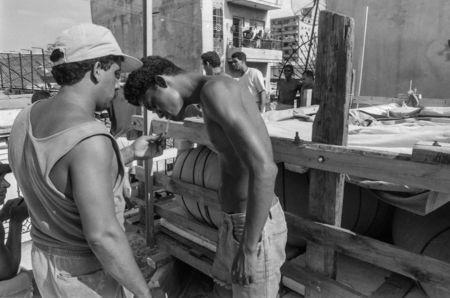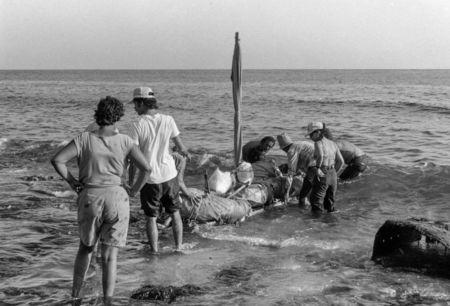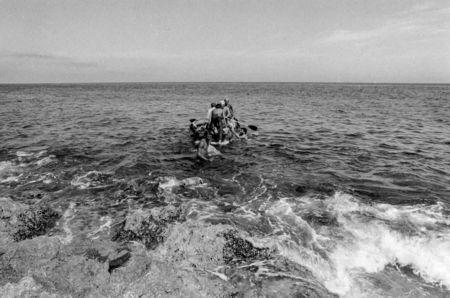Twenty years after Cuban raft exodus, they keep coming
By David Adams MIAMI (Reuters) - Alicia Garcia vividly recalls her rescue at sea 20 years ago during a mass exodus from Cuba, a dramatic event that changed the lives of hundreds of thousands of people and reshaped relations between the communist-run island and the United States. "We didn't think we'd make it. We prayed, and put ourselves in God's hands," she said of her six-day ordeal clinging with five others to a raft made of truck inner tubes and rope. Illegal departures by sea from Cuba are on the rise again, U.S. officials say, with more than 2,000 migrants picked up by the U.S. Coast Guard over the last 12 months. That is the highest rate in six years. Many more are passing undetected, mostly headed west aboard flimsy home-made vessels in a risky bid to cross the Caribbean to Honduras, in hopes of getting across the Mexico-U.S. border. Late last month 17 Cubans were rescued by the Mexican navy after almost a month at sea, 20 days without food. Details are unclear, but more than a dozen others may have died from dehydration - the survivors forced to throw their bodies overboard. The town of Manzanillo in eastern Cuba, where most of the victims are from, planned a church Mass on Friday night. "My wife, she can't bring herself to tell me what really happened. It's too terrible," said Jose Caballero, husband of one of the survivors, who left Cuba via a similar route in December and now lives in Texas. ECONOMY, LONG DELAYS, FUEL EXODUS According to the latest U.S. figures, more than 14,000 Cubans have crossed the southwestern U.S. border illegally since Oct. 1, almost triple the number four years ago. The spike is attributed to delays of up to five years for Cubans seeking to emigrate legally to join relatives in the United States. Economic reforms designed to open up Cuba's state-controlled system and create private sector jobs have also failed to improve living conditions for most people. "We left (Cuba) because there are no jobs or the basic items for living," said Angel, a former fishing boat captain who reached Honduras with 11 others aboard a home-made boat last week after a two-week journey via the Cayman Islands. The boat was built clandestinely with cannibalized parts, including a car engine, a propeller and aluminum sheets sealed together with resin, he said. It wasn't much different in 1994, said Garcia, except on that occasion Cuba lifted restrictions, opening the flood gates for anyone who wanted to jump on a raft. That summer, between Aug. 12 and Sept. 13, some 31,000 Cubans were detained at sea by U.S. ships. It was the largest exodus since the 1980 Mariel boatlift that brought 120,000 Cubans to Miami. The 1994 crisis led to a major shift in U.S.-Cuba policy and an accord under which Washington agreed to grant visas to 20,000 Cuban migrants a year. As a result, since 1995 more than 600,000 Cubans have emigrated to the United States, the largest flow since Fidel Castro's 1959 revolution. The 1994 crisis also led to the establishment of a so-called "wet foot, dry foot policy," under which Cuban migrants who make it onto U.S. soil are allowed to remain, while those intercepted at sea are turned back. Rafters have kept coming in smaller numbers, though these days they make few political or media waves. LIKE FALL OF BERLIN WALL A series of seminars and exhibitions are being held to mark the 1994 exodus. An exhibition at the Spanish Cultural Center in Miami, opening on Saturday, features the work of Willy Castellanos, a young photographer in Havana in 1994 who chronicled the exodus as homes were ripped apart to build rafts, lowered by pulleys onto the street below. "Living in Havana at that time and watching the exodus felt like the fall of the Berlin Wall. It was the end of the utopia, the socialist model we grew up with," he said. Garcia said she will never forget the five months she spent in 1994 at a makeshift refugee camp at the Guantanamo Bay U.S. naval base before making it to Miami. She has not been back to Cuba to visit the grandparents who raised her. Garcia and other rafters say the 1994 exodus has not been fully appreciated by Cubans who arrived in Miami in the 1960s, or on the Mariel boatlift. "The Cubans who came before, in 1980, were never in agreement with the revolution. We were supposed to be different," added Garcia, born in 1974. "We were the children of the revolution." (Reporting by David Adams, editing by Jill Serjeant and Dan Grebler)








